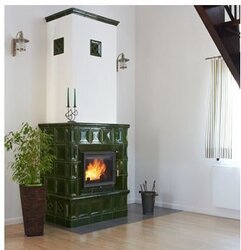I've recently had a fireplace insert installed in the open fireplace, with piping up through the chimney. It's a pretty basic unit but seems big enough for the place, and the several times I've used it, it gets good and hot and seems to be burning well. It certainly helps with the heat, and lovely to watch. It was installed with what seems like decent care despite the issue here.
It doesn't, however, seem to do a very good job of distributing heat. It's been installed with facing around it on the three edges - I forget the name of the material but basically a fire-proof drywall. There is probably 10-12 inches on all three sides before the walls of the old fireplace (firebrick and concrete, it seems). The facing gets good and hot, and eventually the brick of the fireplace (on an exterior wall) gets warm as well, but there's clearly not a lot of air movement around it or in behind the facing and out, so the cast-iron of the insert is obviously generating a lot of hit straight into all that brick - with only the glass door as the main heat source to the room. The insert had a fair amount of room inside the fireplace to the sides and a reasonable amount behind it, but I don't believe there is any clearance to speak of under it. The bottom has a combined air intake/ash pan that provides good circulation into the insert.
This unit doesn't seem to have an option or any kind of blower unit. Any suggestions?
I'm thinking one of two things:
1) Drill some holes at the bottom of the facing to let air in behind to the body of the insert, and either some holes at the top or even remove a chunk of the facing immediately above and install a grill. If I were to do that, perhaps it would make sense to put holes on one side at the bottom and other side at the top?
2) Get someone in to install a blower - I guess at the side or the top. There's no built-in power connection but that can probably be worked out. I presume it must be possible to install for the space around even if the insert itself wasn't designed for one, but I'd obviously like to try the easier of the solutions first.
Any other suggestions (or more detailed ones than what I've thought of here)? I'm inclined to try the small holes/vents and larger holes/vents/grill at the top.
The facing has been screwed into metal bits to hold in place, so should be possible to remove them to look around if needed. Facing is basically flush with the concrete/brick of the original fireplace.
It doesn't, however, seem to do a very good job of distributing heat. It's been installed with facing around it on the three edges - I forget the name of the material but basically a fire-proof drywall. There is probably 10-12 inches on all three sides before the walls of the old fireplace (firebrick and concrete, it seems). The facing gets good and hot, and eventually the brick of the fireplace (on an exterior wall) gets warm as well, but there's clearly not a lot of air movement around it or in behind the facing and out, so the cast-iron of the insert is obviously generating a lot of hit straight into all that brick - with only the glass door as the main heat source to the room. The insert had a fair amount of room inside the fireplace to the sides and a reasonable amount behind it, but I don't believe there is any clearance to speak of under it. The bottom has a combined air intake/ash pan that provides good circulation into the insert.
This unit doesn't seem to have an option or any kind of blower unit. Any suggestions?
I'm thinking one of two things:
1) Drill some holes at the bottom of the facing to let air in behind to the body of the insert, and either some holes at the top or even remove a chunk of the facing immediately above and install a grill. If I were to do that, perhaps it would make sense to put holes on one side at the bottom and other side at the top?
2) Get someone in to install a blower - I guess at the side or the top. There's no built-in power connection but that can probably be worked out. I presume it must be possible to install for the space around even if the insert itself wasn't designed for one, but I'd obviously like to try the easier of the solutions first.
Any other suggestions (or more detailed ones than what I've thought of here)? I'm inclined to try the small holes/vents and larger holes/vents/grill at the top.
The facing has been screwed into metal bits to hold in place, so should be possible to remove them to look around if needed. Facing is basically flush with the concrete/brick of the original fireplace.





